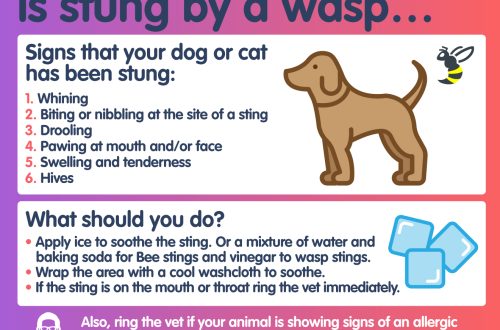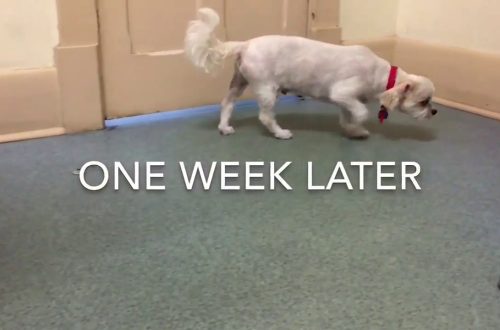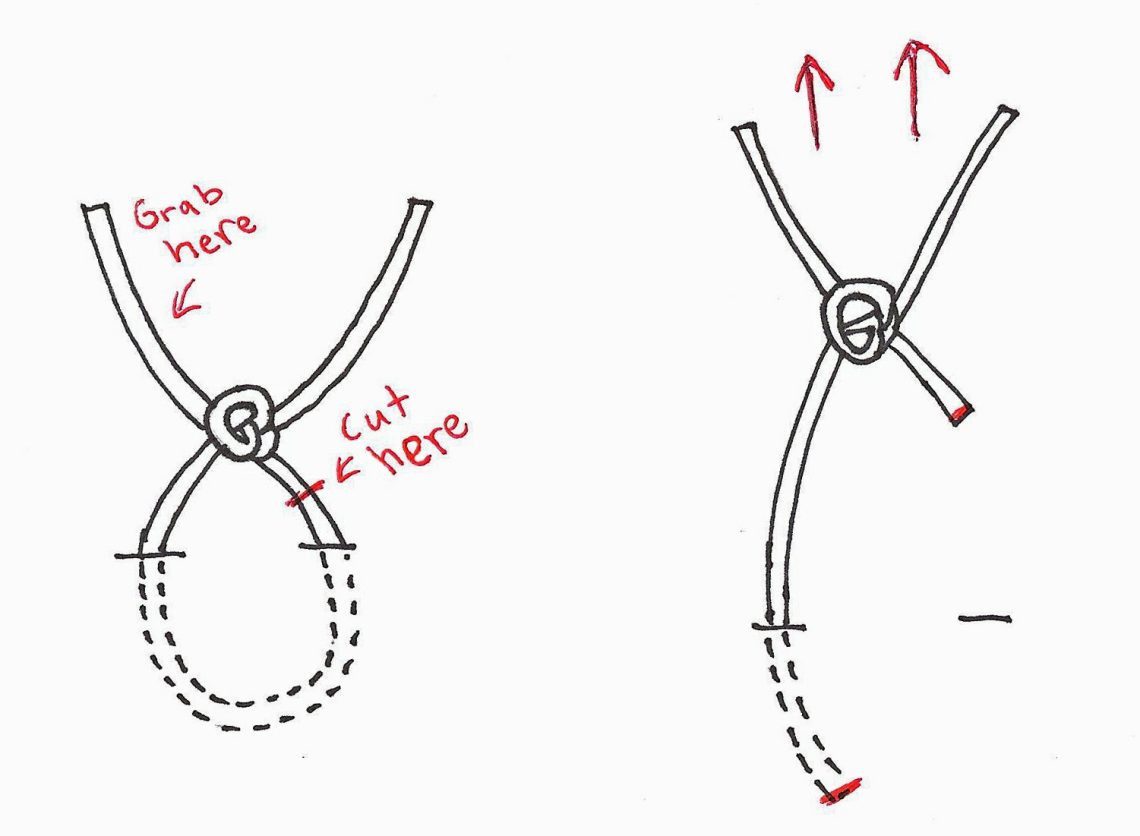
How to remove stitches from a dog at home
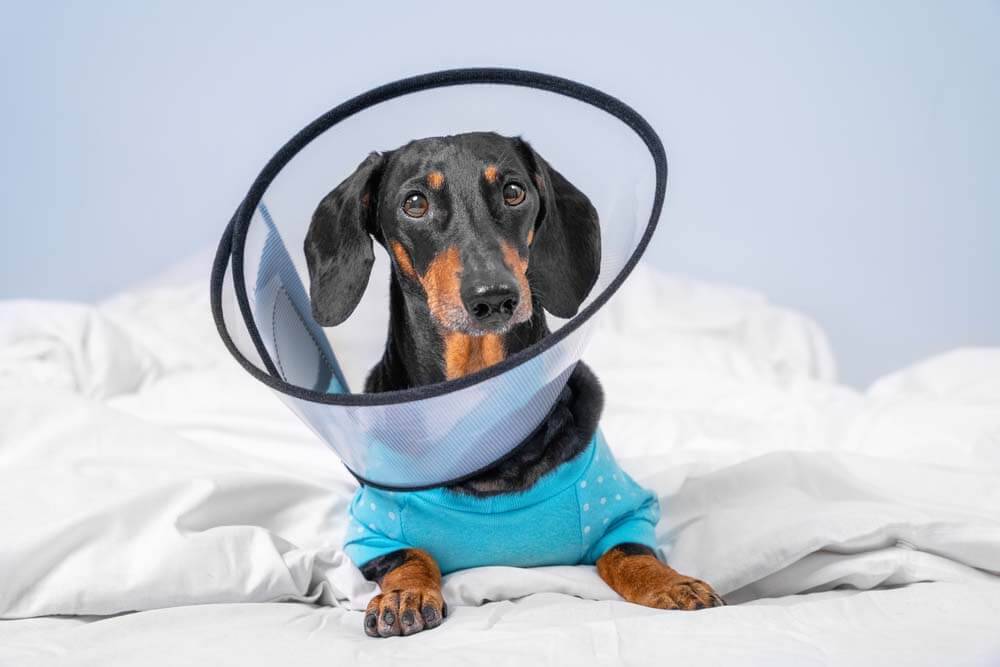
Contents
When can you remove your dog’s stitches yourself?
The main criterion that the suture can be removed independently is the approval of the doctor who performed the operation. Of course, it is always better if the specialist removes the stitches himself, and at the same time performs a postoperative examination of the patient. But in real conditions, when animals are moved to other cities and even countries for surgical interventions, when a pet is kept in a region where veterinary care is completely unavailable, and for a banal, say, ovariohysterectomy (sterilization), a bitch has to travel hundreds of kilometers, the owners are forced remove the stitches yourself.

A bit of theory in order to understand what stitches are, how and why they can be applied.
Sutures are placed on the skin, muscles, mucous tissue, with their help, the integrity of the internal organs, the cornea of the eye is restored. The sutures are “clean” – when the incision is made during the operation, in the clinic, and “dirty” – when the wound resulting from an injury is sutured.
It is permissible to remove stitches at home only if they are applied to the skin.
Skin sutures can be continuous (if the entire wound is sutured from beginning to end with one thread, and the nodules are located only at the beginning and end of the suture), knotted (single stitches or a complex injection system with one knot) or submerged, that is, on the surface of the wound of the suture material will not be visible. The latter are performed using absorbable threads, they do not require removal, and we will not consider them in this article.
Thus, you can remove the stitches from the dog yourself if:
The doctor who performed the operation approved your independence.
Sutures are placed on the skin.
The area of interest has no signs of inflammation (no swelling, itching, redness, severe pain, pus).
You have a trusted assistant to hold your dog during the procedure.
You are mentally and physically ready for this.
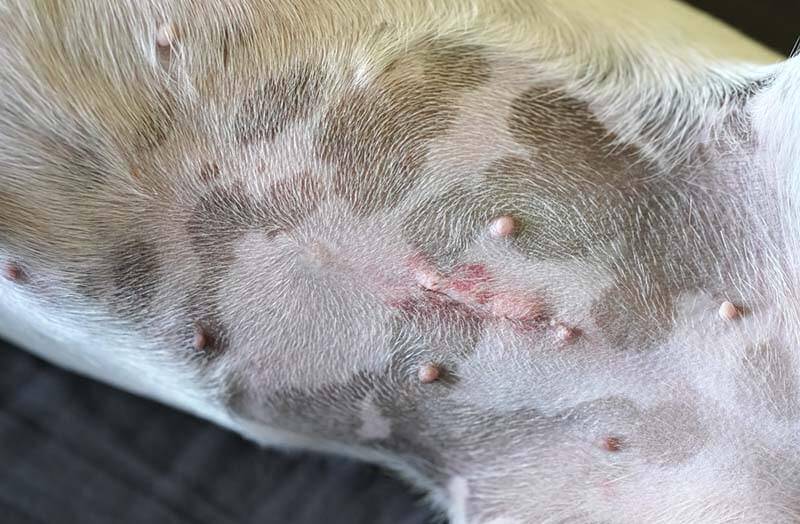
How to determine that the seam can be removed?
How many days the suture should be on the skin, the doctor who performed the operation will tell you. The duration of wearing stitches depends on many factors:
Places of overlap
Reasons for imposition
The presence or absence of drains, systems for removing fluid from the wound cavity
The presence or absence of postoperative complications.
On average, the sutures are removed from the skin for 10-14 days.
The suture to be removed must be dry, clean, without swelling, redness, any bumps, ulcers or abrasions. The surgical wound itself must heal completely.
If the suture is removed too soon, the tissue may not heal well enough and the suture will fall apart. If the suture material remains in the wound for too long, it is fraught with its ingrowth and inflammatory processes, rejection of the threads.
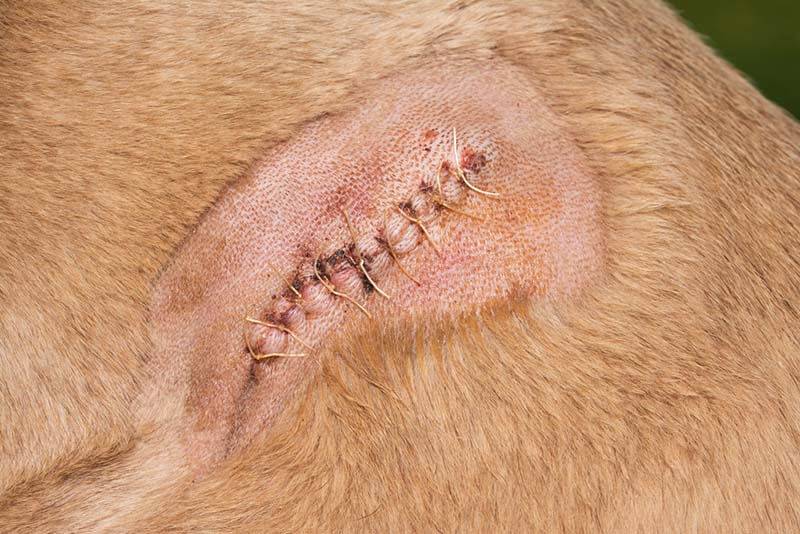
Preparation for suture removal
The most important thing for successful removal of stitches at home is your morale, attitude. In order for everything to turn out well, you need to thoroughly prepare.
First of all, you should choose a place. If the animal is large, then it is probably best to remove the stitches from the dog on the floor, but if the patient weighs little, then it is more convenient to perform manipulations on the table (washing machine or other strong elevation). It is important that both you and your helper can easily approach the animal. It also requires that it be light, and there are no sharp corners and objects around that can injure you or the dog.
The assistant needs to be mentally prepared for the procedure and physically cope with the pet. In addition, he should not frighten or unnerve him. Familiarity is also better not to show.
Prepare a muzzle or bandage in order to protect yourself from bites, and the dog from injury (biting scissors, for example, can seriously injure him).
From tools you will need sharp small scissors with blunt ends and tweezers. They must be treated with an antiseptic solution or boiled.
In addition, take gloves, alcohol, an aqueous solution of chlorhexidine 0,05%, a solution of sodium chloride 0,09% (saline), surgical wipes (can be replaced with a bandage, but it will need to be cut and folded several times, do everything with clean hands and instrument).
Put all this not where the animal will be located, but in the access zone – on a table nearby, on the windowsill, away from you. This is necessary so that during fixation and possible resistance, the patient does not scatter anything.

Instructions for removing stitches in dogs
It is necessary to calm the dog, create a comfortable psychological environment, put a muzzle on it.
Put on disposable gloves and clean them with alcohol.
Fix the animal with the help of an assistant so that the zone of interest is accessible.
Examine and feel the wound. If the seam looks solid (tissues have grown together), you do not see signs of inflammation, then you can continue. If the appearance of the seam raises questions (there is pus, blood on the surface, ulcers, abrasions, bumps, swelling, bruises are visualized, the wound has an unpleasant odor, the skin around is reddened or swollen) – removal is possible only by a veterinarian, most likely there are complications.
Remove crusts, dust and dirt from the surface of the skin and the seam with a surgical drape soaked in saline or in an aqueous solution of chlorhexidine 0,05%.
If the seam is nodal, and you are right-handed, then you need to hold the ends of the threads with tweezers or fingers of your left hand, pull the suture material away from you and up, lifting the knot above the level of the skin. Place the scissors between the knot and the skin, cut the thread, pull out the entire seam. Repeat the action with all the stitches on the wound.
If you are left-handed, then act like a mirror. Pull the thread with your right hand, and cut it with your left.
If the seam is continuous (for example, the seam after sterilization in a dog), then each stitch will have to be removed separately. The fact is that a significant amount of bacteria collects on the thread that is outside, and it is painful to pull a long thread through the skin. Therefore, pull the ends of the thread away from you and up with tweezers or fingers of your left hand, wind the scissors between the skin and the knot, cut it. Next, with tweezers or a finger, pull up the free part of each stitch, cut, pull. Remember to remove the knot at the very end of the seam.
If you are left-handed, act in reverse. That is, with your right hand, with or without tweezers, pull the thread, and in your left hand, hold the scissors.
After all the threads have been removed, wipe the suture with an aqueous solution of chlorhexidine 0,05% applied to a gauze swab (bandage).
Take care to keep the area of interest clean for at least a couple more days. It is important that the dog does not lick the place where the seam was for some time. Use a post-op blanket, collar, bandage, or all three to protect the scar from dirt and licking.
Praise the pet, calm down, relax, give a treat.
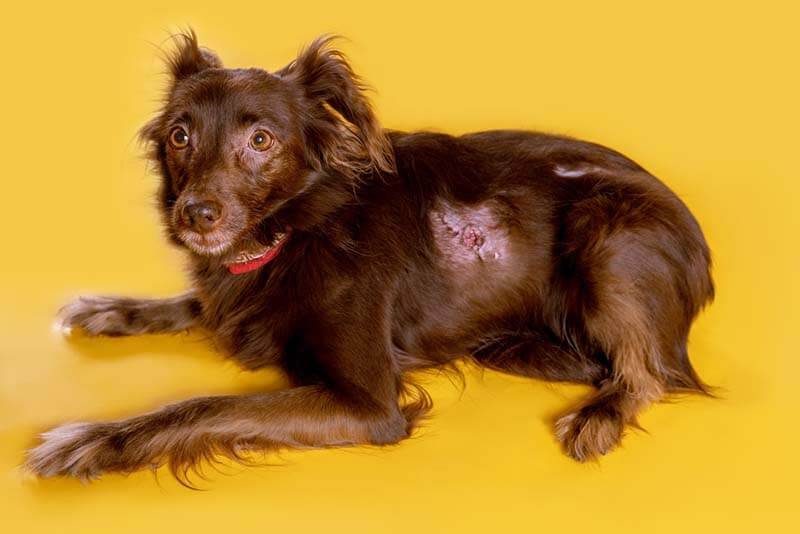
Possible errors and complications
The biggest mistake is to overestimate your strength and not keep the pet. This can cause injury to both the dog and people. When fixing, the assistant should be calm and friendly, but persistent and adamant. The better the animal is fixed, the calmer it will behave.
In no case do not neglect the muzzle, if there is none, tie your mouth with a bandage.
If you realize that you can not cope with the dog, contact the experts!
Also a common mistake is the application of aggressive antiseptics on the seam and the place of its removal. There is no need to do this, since the processes of regeneration (tissue fusion) will be greatly inhibited.
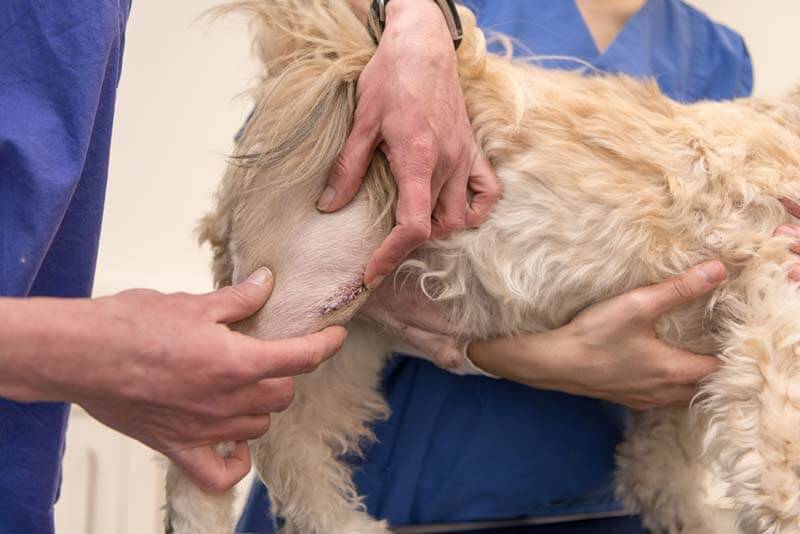
A situation is possible in which part of the suture material cannot be removed, or some kind of suture was missed, and it remained not removed. Such a seam can grow in. Either it will resolve over time, or an abscess will begin to form in its place. How events will develop depends on many factors: what kind of suture material is used, whether the dog has an individual reaction, whether an infection has got in. If you see something strange at the site of the removed stitch – swelling, redness, bumps, discoloration of the skin, or the pet is worried about this place, then you should contact your veterinarian.
If it is incorrect to assess the consistency of the seam, then after removing the threads, it may disperse, and the edges of the wound may begin to gape. In order not to be in such a frightening situation, you need to carefully examine the seam before removing it.
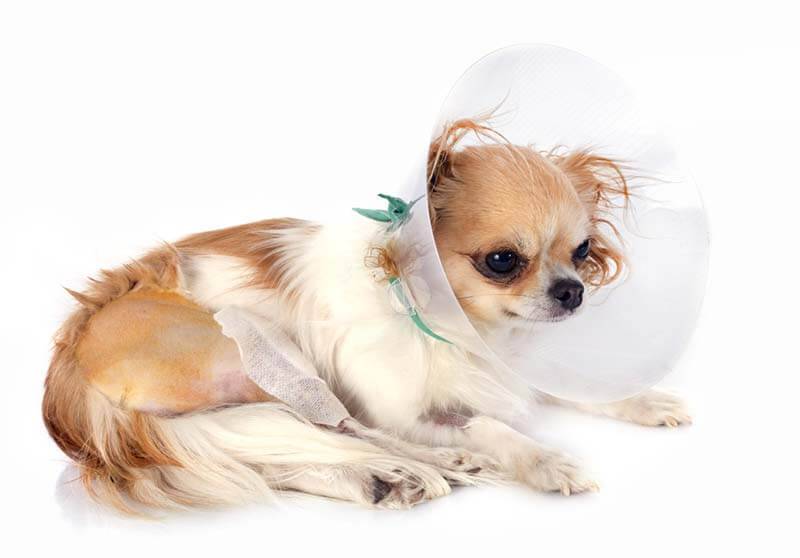
Veterinarian advice
If you are not confident in your abilities, do not start the procedure.
Be sure to discuss with the doctor who performs the operation that you plan to remove the stitches yourself. The doctor will show which stitches are in place, where they are, how many there are. If possible, place a dip suture that does not need to be removed at all.
When choosing a place to cut the thread, look for the closest point to the skin so that the part of the thread that was outside gets into its inner layers as little as possible.
How to remove stitches on a dog’s stomach? You should not turn it over on its back, animals are very scared of such a pose. It is better to lay the pet on its side, in this position the most important thing for the assistant is to hold the front and hind legs, which turned out to be below, because only by pulling them under him, the dog will be able to stand up.
If there is no muzzle, fold a wide bandage in half, put on a single knot that forms a loop in the middle. It should be on top of the mouth. Wrap the muzzle again with a bandage, tighten the knot under the muzzle, then tie a bow behind the ears. So the dog will not be able to remove this mating, and you can easily. It is acceptable to use a belt, for example, from a terry bathrobe, but not a rope that can cause injury.
To protect brachycephalic breeds (French Bulldog, Pug, Dogue de Bordeaux) from teeth, a postoperative collar is usually used. If this is not available, it can be made from a larger or smaller plastic bottle, depending on the dimensions of the patient.
A small dog is most often comfortably fixed by gently swaddling it in a towel or blanket if the seam is not located on the body.
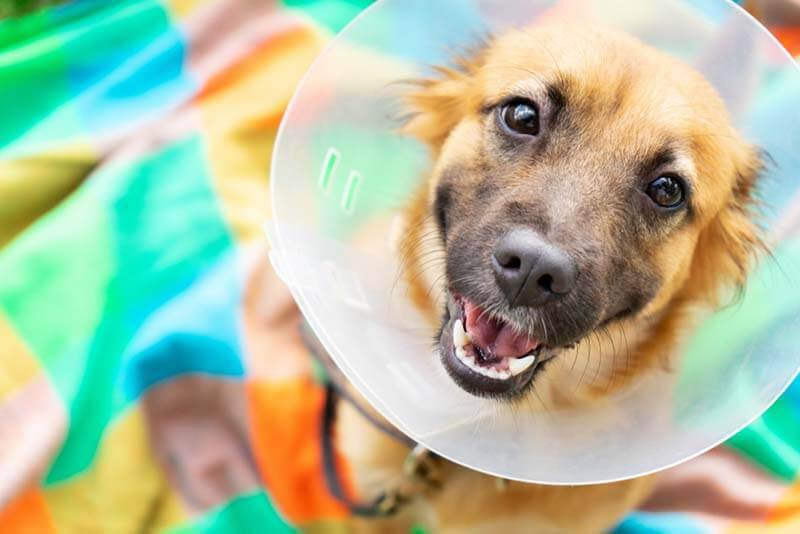
Postoperative care guide
In order to remove the stitches in the dog was possible, postoperative care for them should be as adequate as possible.
A universal condition for all seams is that they must be clean, dry and protected from being licked by a dog or other animals.
It is enough to wipe a clean seam after a planned operation in the first days from the formed crusts with a solution of sodium chloride 0,9% or an aqueous solution of chlorhexidine 0,05%.
If the suture was applied after an injury (cut, tear, bite), that is, the wound was initially “dirty”, then the attending physician will give individual recommendations for processing and care. Also individually, the doctor will tell you how to care for wounds with drains, or for a part of the wound left unsutured for any reason.
Answers to frequently asked questions
April 8 2022
Updated: April 8, 2022




